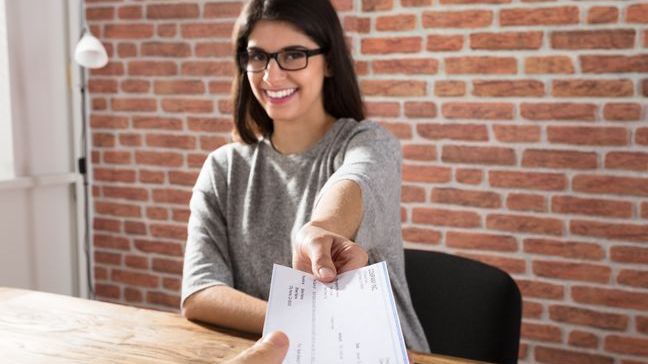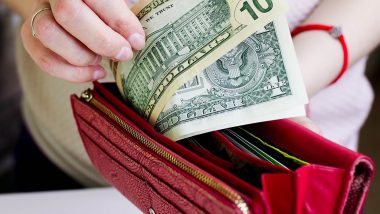If you can’t remember the last time you filled out a check, don’t worry. Thanks to credit cards and companies like Venmo and Cash App, checks have certainly become less necessary in recent years. However, checks still have many relevant uses today.
For example, some companies charge a fee for large purchases made with a debit or credit card, but won’t charge you if you pay by check. Not to mention that birthday, holiday or wedding gifts are more often received by check than cash.
For these and other reasons, it is important that you know how to fill out and read a check correctly.
How to fill out a check
To complete the verification, you need to fill in six fields.
1. Date
First, in the upper right corner of the check, you will write the date—usually the current date.
In some cases, you can also specify a future date if you don’t want the recipient to cash the check right away.
2. Payee

Next, you write the name of the person or company receiving the check.
Your check should say “Pay To” or “Pay To The Order Of” followed by the recipient’s name. Pay attention to the spelling here, as some banks may refuse to cash a check if the name is misspelled.
Finally, if you choose to do so, you can write “Cash” on the payee line. This entitles anyone with a check to cash it, so only do so if absolutely necessary.
3 and 4. Amount (in numbers and words)
When you enter the value of your check, you must fill in two fields: one in the form of a number written in words, the other in numerical form.
Writing this information in two different ways helps ensure that the amount you want to pay is recorded accurately.
Numerical value

Recording a numeric value is self-explanatory. However, make sure you use the correct punctuation and complete the field so that someone cannot add numbers and commit fraud.
If the numbers don’t fill the entire field, just write a dash from the last number to the edge of the field.
Written cost

Some people find it difficult to write down the amount they want to pay in writing. One easy way to make this step easier is to think about how you would say the number out loud.
For example, with $2450 you would say “two thousand four hundred and fifty”. Again, remember to use proper punctuation. In particular, if you’re using a number between 21 and 99, you’ll usually need a hyphen (for example, fifty-two).
Finally, if your number includes change, such as $0.42, write it as a fraction. In this case, $0.42 would be written as “42/100”. Also, you must use the word “and” between dollars and cents.
So, if your check was for $5,302.55, you would write it like this: “Five thousand three hundred and two and 55/100.”
5. Memo

This is another relatively clear section. You will use this field on a check to determine the purpose of the check. For example, “Rent for February 2024” or “Happy birthday.”
The commemorative part of your receipt is more important to track than anything else, so don’t worry too much about what to write here.
6. Signature

The last section of your check that needs to be completed is the signature. This is the most important field because if you don’t sign the check, it can’t be cashed.
In fact, most banks charge you a fee for issuing an invalid check, as this creates additional inconvenience for them.
How to read a check
In addition to knowing what information to include on each of the six fields on your check, you also need to understand the three numbers on the bottom of every check.
1. Bank routing number

The first number you will see in the bottom left corner of the check is the bank routing number. This number consists of nine digits and is used to identify the respective bank from which money can be withdrawn.
(Obviously, in the example above, we’re using a fake check, so don’t worry if the numbers don’t look exactly like your real check!)
Account number

Further, at the bottom in the middle of the check you will find the number of your individual current account. This number identifies your unique bank account.
Check number

Finally, the last number on the line at the bottom of your check (far right) is the check number. This will help you keep track of which check you use for which purpose.
This number is also located in the upper right corner of the receipt.
Check out writing tips
Keep detailed records
Make sure you keep track of check usage in the check register. This will help you make sure you never write a check in the future for more than what is available in your account. Also, since your bank statement will most likely only include the check number and amount, keeping track of check transactions will help you remember the purpose of each check you use.
When recording information in a check journal, be sure to include the amount paid, the check number, the date you issued it, and information about why and to whom the check was issued.
Know how to void a check
Sometimes when you want to set up regular online payments (for a mortgage, for example) or direct deposit from your employer, you may need a canceled check to complete the process.
In this case, you will write “VOID” in large block letters all over the front and back of the check. Make sure you don’t obscure the account number and bank routing number. Another option is to write “cancelled” in each of the check fields (“Pay by”, date, amount, etc.).
Additional Recommendations
- Always use a pen, not a pencil.
- Be sure to fill in the amount line completely.
- Avoid signing blank checks.
- Avoid using “Cash” in the “Pay To” field unless absolutely necessary.
- Always complete the signing part of a check last and make sure all information is correct before signing.
Summary
Today, many Americans prefer to use debit or credit cards, automatic bill payments, and even cash rather than checks. However, there are some scenarios where verification may be justified or even preferred.
Make sure you understand how to properly complete a check by completing all six fields, and learn safe check writing practices such as using a pen and signing last to protect your bank account.
Featured image: Andrey_Popov/Shutterstock.com
Check out the images: iQoncept/Shutterstock.com

